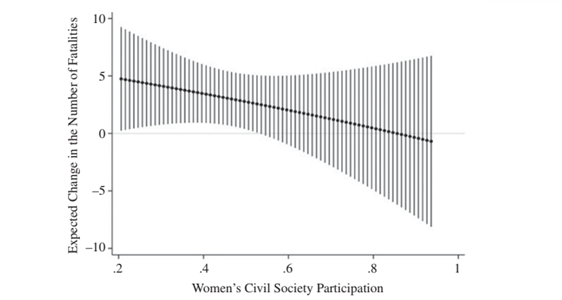
Written by: Leandra Bhathal Serrano
Edited by: Cristina Perez Escolar
Executive summary
The number of women implicated in terrorism-related crimes is growing. This tendency is part of the new initiatives and adaptation strategies undertaken by terrorist groups. In order to combat these security issues efficiently and mitigate the threat of terrorism, organisations must foster a secure environment for both individuals and communities by cooperating, coordinating, and developing impactful policies. Thus, this policy brief will delve into the underlying causes and advantages that propel women to become suicide bombers in terrorist organisations and terrorist organisations to recruit more women than ever. Finally, it will provide some recommendations aimed at policy-makers and law enforcement authorities.
Introduction
While women have often been perceived as the primary targets of terrorism, it is important to recognise that they also play significant roles within terrorist movements, sometimes serving as instigators themselves (Bloom et al., 2023, p. 400). The involvement and participation of women in terrorism-related offences has been consistently increasing over time (Vogelstein, 2019; Bigio et al., 2019, p. 1). In fact, during recent years we have witnessed an increase in suicide attacks perpetrated by female suicide bombers worldwide (Vogelstein, 2019; Bigio et al., 2019, p. 1).
Prior to 1990, the Liberation Tigers of Tamil Eelam (LTTE), a Sri Lankan terrorist group, had a relatively small number of female combatants, but this changed rapidly afterward. The emergence of their women’s military wing marked a shift in their modus operandi. Notably, the LTTE’s suicide unit, the Black Tigers, included a significant female presence. Estimates of the proportion of female combatants within the LTTE vary, ranging from approximately 15 to 20 percent to as much as one-third of their core combat strength, with some claims suggesting even higher figures (Alison, 2003, p. 39). In 2014, Boko Haram, another Islamist jihadist terrorist organisation based in Nigeria, which is also active in Chad, Cameroon, Mali and Niger, started to incorporate women into their activities. Since then, women have been coerced into perpetrating attacks targeting civilians at public locations. Between 2014 and 2016, Boko Haram executed 89 attacks, resulting in over 1,200 deaths (Bloom et al., 2016, p. 105). According to some terrorism researchers such as Charlie Winter and Devorah Margolin, ISIS’ stance on women in combat has recently evolved from prohibition to encouragement. Following the first suicide bombing carried out by a woman in 2002 under the umbrella of Fatah, Hamas began to recruit women, and opened the doors to female participation in violence (Margolin, 2019, p. 41, p. 46; Erez et al. 2019, p. 6).
Usually, suicide attacks result in 26 times more casualties and four times more fatalities compared to other forms of terrorism employing traditional methods such as kidnaping, hidden explosive bombings and incendiary bombings, assassinations, or armed assaults (UNCCT, 2017, p. 11; Royal United Services Institute, 2007). Consequently, the increase of female suicide bombers raises concerns about the potential role of women as significant participants in forthcoming terrorist attacks on a global scale (Bloom et al., 2023, p. 401).
The conventional understanding of women’s involvement in terrorism and violent extremism has been influenced by a patriarchal viewpoint, emphasising the control of power by men. Scholars must question the notion that women only have restricted roles and, instead, acknowledge their active agency in engaging in acts of violence. The global phenomenon of women’s empowerment and their readiness to join terrorist groups transcends various societal sectors, challenging preconceived notions about their roles in such activities (Sides et al., 2013; Bloom et al., 2023, p. 400). Due to this reason, this policy brief is addressed to policy-makers in the field of security, terrorism and gender studies.
As a political scientist conducting research in the security field, it is vital to investigate the diverse security threats that affect safety and peace. In our industrialised and globalised world, assessing and studying women’s role in terrorism, its consequences and dangers is also crucial. This social phenomenon is constantly evolving, and, in order to develop consistent and sensitive policies a more in-depth study might seem to be necessary. Thus, further “Wars on Terror” and crises could be avoided, risks would be minimised, and global security will be improved.
To achieve these goals, our efforts are concentrated on researching the dynamics behind female suicide bombers. Accordingly, this paper commences with a general overview of the advantages and reasons why women become and are used as suicide bombers. Subsequently, some policy recommendations will be developed to help ensure a more robust common security framework. In the final segment, the main conclusions will be drawn.
Problem Description & Background
Women have gone from playing invisible, behind-the-scenes roles to very front-line and operational roles. Concerning this process, it is essential to understand what roles and why women turn into terrorists (Speckhard, 2014). Terrorism scholars such as Mia Bloom have elucidated that, although both men and women may share a similar inclination for violence, cultural constructs can constrain their roles and suggest diverse levels of agency within terrorist groups (Bloom et al., 2023, p. 400). Women’s activities in terrorism have been diverse and multifaceted: assassin, trainer, martyr, internet investigator, translator, ideologue, instigator, propaganda, fundraiser, recruitment, hijacking, seducer, bomb maker, saboteur, among many others (Speckhard, 2014).
Nowdays, suicide bombing stands out as one of the most potent weapons in the possession of terrorists. It is to highlight that the role in which women have had the most impact during the last years has been the one of suicide bombers. While the individual motivations of female suicide terrorists may vary from the terrorist organisation’s reasons for their recruitment, there is a convergence occurring, resulting in a heightened presence of women involved in terrorism (Von Knop, 2007, p. 398-399).
- Reasons why some women are chosen to join the organisation
Women are considered highly valuable as suicide operatives within terrorist groups due to their perceived expendability. This is attributed to their often subservient roles and infrequent engagement in essential or leadership positions (Speckhard, 2008, p. 995, 1002). The cost-effectiveness and high return on investment further contribute to suicide bombing being considered an optimal attack method (Zedalis 2004, p. 7-10). Female members of Boko Haram have proven highly effective, causing over 1,200 fatalities and injuring around 3,000 individuals between 2014 and 2018. As a result, women now constitute nearly two-thirds of the group’s suicide attackers (Campbell, 2020; Bigio et al., 2019, p. 4, 12).
Not only does suicide bombing take into account the time and the environment to kill the highest number of people, but terrorist groups are also motivated to use women for tactical advantages (Bloom, 2011). Women can evade detection and conceal bombs at checkpoints because they are less anticipated, and, in many cases and contexts, searching them is a sensitive issue due to the sanctity associated with a woman’s body, making it a delicate matter for male authorities. An example is the one of the Indian Prime Minister Rajiv Gandhi, who was assassinated by a woman member of the Liberation Tigers of Tamil Eelam (LTTE) wearing an RDX6 explosive-laden belt hidden under her dress (Fineman, 1991). Consequently, terrorist organisations leverage gender stereotypes to enhance their access to and penetration of targets more effectively (Balogh, 2016, p. 2).
Another great benefit exploited by terrorist organisations is the media dimension. The concept of women serving as perpetrators of violence goes against conventional expectations of femininity (Nacos, 2005, p. 435). Images of female terrorists garner significant attention and help propagate the organisation’s message to a broader audience. The unexpected, horrifying, and devastating impact of suicide bombings generates heightened psychological awareness and fear among audiences compared to other tactics (ibid.). Terrorist groups are aware of and capitalise on cultural gender stereotypes that are reinforced by the media. Since terrorism is a social phenomenon involving the “deliberate creation and exploitation of fear through violence or the threat of violence in the pursuit of political change, visibility is crucial” (Hoffman 2006) (ibid.). A widely known example was the one of Muriel Degauque, who, hailing from a Catholic family in Belgium, gained notoriety as the first female European suicide bomber. In 2005, she detonated her suicide vest in Iraq. Her case serves as a compelling illustration of the contemporary face of terrorism: a European woman, choosing to engage in the most extreme form of terrorism – suicide bombing (Bloom, 2007, p. 94, 101).
- Individual or Personal Reasons
Concerning the individual reasons why women become suicide bombers at an individual level, many scholars have explained the reasons why female terrorism is on the rise. Mia Bloom explained that some reasons are redemption, something in their past they hope to reinvent themselves, and revenge due to the loss of family members (Bloom, 2011). A notable illustration is the case of female Chechen terrorists, commonly referred to as “Shahidka” or “Black Widows.” By adopting the symbol of the widow, dressed entirely in black, these individuals reinforced the perception of a widow seeking vengeance, turning to terrorism due to the loss of their husband, brother, son, or father at the hands of Russian forces, depicting a woman driven by a compelling personal motive (Balogh, 2016, p. 2; Nacos, 2005, p. 440).
Another reason why they become suicide bombers is to gain the respect of their community and be honoured by the society they are living in. Also, due to a relationship with a male member of a terrorist organisation, terrorism becomes a family business. It ensures the person is not an informer and will not change their ideas (Bloom, 2011). Furthermore, raping also pushes women to become suicide bombers. Women that have been raped are considered damaged goods for the societies. Therefore, these women are convinced they can do more with their death than they can ever do in their lives. They are also told that these terrorist acts will make them regain their personal or family honour. This was also the case in Chechnya, the Black Widows recruited women that Russian soldiers raped as a way to offer them a path to reclaim lost family honour (Buchanan, 2014, p. 31). Terrorist groups also take advantage of psychologically damaged and more vulnerable women (Von Knop, 2007, p. 400-402). Many of Boko Haram’s suicide attacks were conducted by extremely young girls that had been victims of rape and that suffered psychological trauma (Bloom et al., 2016, p. 111).
Finally, taking a more contentious perspective, one could argue that women considered ‘unsuccessful’ -not married or sterile- may perceive themselves as being marginalised in society, rendering them susceptible to exploitation by terrorist groups. These individuals might believe self-sacrifice is the only means of reclaiming societal worth (Preesman, 2021). Across her research, Speckhard argued that women generally engage in this activity voluntarily rather than being compelled or coerced. However, one must not neglect that their motivation often stems from trauma and despair (Speckhard, 2008, p. 995, 1013).
Policy Options and Recommendations
Terrorism is one of the leading security sectors in which the national authorities and supranational agencies collaborate, coordinate and cooperate to counter this security threat. During the last decades, we have witnessed a change in the modus operandi and strategies used by terrorist organisations, and the use of female suicide bombers has become central in many parts of the world. Even if this issue is not an imminent threat at the global level, everything can happen in the new scenario, marked by the rapid proliferation of heightened vulnerabilities and the complex interplay of multifaceted challenges, wars and crises. As radicalisation leading to terrorism is growing, female suicide bombers could be the next international threat. This part of the paper will present some possible countermeasures to prevent this problem from taking an extensive and alarming global spectrum.
- Prevention and Radicalisation
To start with, when assessing the problem of suicide terrorists from a general perspective, prevention is of overriding importance. Preventive measures primarily involve hindering perpetrators from physically reaching their targets. This is achieved through physical barriers, strict border controls, scrupulous security screening, preventive detentions, surveillance, and intelligence. Additionally, efforts should also be directed towards countering terrorist organisations since they hold the necessary infrastructure to execute suicide attacks and to decrease the quantity or profile of potentially symbolic targets, times and locations to conduct preventive arrests of terrorists (Džigumović, 2019, p. 199-200).
However, one crucial preventive measure is to invest and conduct further psychological, sociological and overall academic research about the terrorist and extremist radicalisation of women to be able to understand the rationale and cost-benefit calculation of a female suicide bomber, its characteristics and modus operandi and raise awareness about the issue. It is essential to know the factors conducive to it, the female terrorists’ background, motivations, context, roles, ideology and the path towards the acquisition of a “radical mental universe” (Council of Europe, 2014, p. 5). Only through this can security forces and policy-makers be able to develop de-radicalisation programs in detention centres and in recruitment arenas (European Commission, 2023). Moreover, this knowledge will also contribute to undermine the appeal to violent extremism and limit the pool of potential female suicide recruits by terrorist organisations and groups (Džigumović, 2019, p. 203-4).
- Integrating Gender Perspective into Policy-making
Another important aspect that should be considered is the gendered nature of policies and the implementation of those. When policies rely on stereotypical assumptions, such as the mistaken belief that violence, extremism and terrorism exclusively pertain to men, the resulting policies and countermeasures are useless (Council of Europe, 2014). However, it is not only about policies; the problem often comes from security forces and law enforcement actors that allow such gendered stereotypes to affect their behaviours and actions. Many scholars (Bloom, 2005; O’Rourke, 2009; Sjoberg et al., 2008; Gonzalez-Perez, 2011; Thomas, 2021, p. 67-68) found that there is a correlation between the lethality of terrorist attacks perpetrated by suicide bombers, the existing gender norms and stereotypes and women’s rights and political participation in the country targeted. Gender norms, again, generate preconceptions that women are peaceful, “innocent” and not politically engaged. This results in counterterrorism efforts neglecting the potential harm that could be caused by women (Thomas, 2021, p. 793, 796). Subsequently,, in societies where women’s role in public life, politics, and rights are limited; attacks by perpetrated female suicide bombers are much more effective (idem: 769) (See Figure 1).

Combatting this form of terrorism is likely to be unsuccessful as long as gender norms persist or until law enforcement becomes immune to their influence. In most countries and societies, gender stereotypes, sexism, and gender violence are still a reality impacting all areas (Council of Europe, 2023). This issue should be combatted through education, training, legislation on gender equality, implementation of awareness-raising campaigns, putting in place complaint mechanisms and access to justice, disciplinary measures and support services (ibid.).
Conclusion
In conclusion, the increasing involvement of women in terrorism, mainly as suicide bombers, presents a complex and multifaceted challenge for many countries, and could become a main global issue. The motivations for women engaging in terrorism are diverse, encompassing individual factors such as redemption, revenge, and societal acceptance. From the perspective of terrorist organisations, women are seen as valuable assets for suicide operations due to perceived expendability, tactical advantages, and the media attention garnered by breaking conventional expectations of femininity.
Addressing this issue requires a nuanced understanding of both organisational and individual motivations. From a policy perspective, countries must adapt and develop sharp countermeasures tailored to their unique context, values, and challenges while cooperating and collaborating with partners, international organisations, and law enforcement agencies. Prevention efforts should involve a combination of physical barriers, border controls, security screening, and intelligence operations. However, a crucial aspect is investing in comprehensive research on the radicalisation of women, understanding their motives, roles, and ideological paths, to inform effective de-radicalisation programs.
Furthermore, integrating a gender perspective into policy-making is essential. Gendered stereotypes and assumptions about terrorism can lead to ineffective counterterrorism measures. Countries must combat gender norms within their policies, security forces, and law enforcement, acknowledging the potential harm that could be caused by women involved in terrorism. Education, training, legislation on gender equality, awareness-raising campaigns, and support services are crucial components of this effort.
As terrorism continues to evolve, countries must remain proactive, adaptive, and inclusive in their approach to counter the threat posed by female involvement in terrorism, particularly as suicide bombers and develop human rights-compliant preventive actions and policies.
Bibliography
Alison (2003). “Cogs in the Wheel? Women in the Liberation Tigers of Tamil Eelam”. Civil Wars, Vol.6, No.4, pp.37-54, DOI: 10.1080/1369824042000221367.
Balogh (2016). “Counter-IED Report: Female Roles Related to IEDs”, NATO HQ SACT, Autumn 2016.
Bigio and Vogelstein (2019). “Women and terrorism: hidden threats, forgotten partners”. Council on Foreign Relations.
Buchanan (2014). “Women in terrorism: Exploring the motivations of women joining terrorist organisations”, Senior Honors Projects, 2010-current, 393.
Bloom and Lokmanoglu (2023). “From Pawn to Knights: The Changing Role of Women’s Agency in Terrorism?”, Studies in Conflict & Terrorism, 46:4, 399-414.
Bloom (2005). Dying To Kill: The Allure of Suicide Terror. Columbia University Press.
Bloom (2007). Female Suicide Bombers: A Global Trend. Daedalus, 136(1), 94–102.
Bloom (2011). TEDxPSU – Mia Bloom – Seeing the New Face of Terrorism, 6 December 2011.
Bloom at al. (2016). “Women as Symbols and Swords in Boko Haram’s Terror”. Center for Complex Operations, PRISM 6, no. 1.
Bloom at al. (2016). Women as Symbols and Swords in Boko Haram’s Terror”, Prism 6, no. 1 (2016): 105-121.
Campbell (2020). “Women, Boko Haram, and Suicide Bombings”.
Council of Europe (2014). Discussion Paper on Possible Gender-Related Priorities. Secretariat of the Terrorism Division Information Society and Action against Crime Directorate, DG I. Committee of Experts on Terrorism (Codexter).
Council of Europe (2023). “Sexism: See it. Name it. Stop it”.
Džigumović (2019). “Policy Recommendations for the Prevention and Deterrence of Suicide Bombing Attacks”. Zbornik Radova-Međunarodna Znanstveno-Stručna Konferencija.
Erez at al. (2019). “Palestinian Women in Terrorism: A Double-Edged Sword?”. International Journal of Offender Therapy and Comparative Criminology, 64 (5). pp. 443-469. ISSN 0306-624X.
European Commission (2023). “Prevention of radicalisation”.
Fineman (1991). “Assassin Greeted Gandhi With a Bomb on Her Back”. Los Angeles Times.
Gonzalez-Perez (2011). “The False Islamization of Female Suicide Bombers”. Gender Issues 28 (1–2):50–65.
Hoffman, B. (2006). Inside Terrorism (REV-Revised, 2). Columbia University Press.
Nacos (2005). “The Portrayal of Female Terrorists in the Media: Similar Framing Patterns in the News Coverage of Women in Politics and in Terrorism”, Studies in Conflict & Terrorism, 28:5, 435-451, DOI: 10.1080/10576100500180352
Margolin (2019). “The Changing Roles of Women in Violent Islamist Groups”. In: Alexander (ed.) Perspectives on the Future of Women, Gender, and Violent Extremism, 40-50. The George Washington University.
Sides and Gross (2013). “Stereotypes of Muslims and Support for the War on Terror”, George Washington University. Journal of Politics 75:3, pages 567-847. Cambridge University Press.
Sjoberg at al. (2008). “Reduced to Bad Sex: Narratives of Violent Women from the Bible to the War on Terror”. International Relations 22 (1):5–23. SAGE Publications Los Angeles, London, New Delhi and Singapore.
Speckhard (2008). “The Emergence of Female Suicide Terrorists, Studies in Conflict & Terrorism”, 31:11, 995-1023, DOI: 10.1080/10576100802408121
Speckhard (2015). “Anne Speckhard Speaking on Women’s Roles in Terrorism”, Defying Extremisms: Gendered Responses to Religious Violence Conference for the Joan B. Kroc Institute for Peace & Justice at the University of San Diego and the IPJ Women PeaceMakers Program, 7 July 2015.
(OSCE) The Organization for Security and Co-operation in Europe (2011). “Women and Terrorist Radicalization: The Role and Empowerment of Women in Countering Violent Extremism and Radicalization that Lead to Terrorism”, Vienna. Final Report, OSCE Secretariat – OSCE ODIHR Expert Roundtables; Preventing Women Terrorist Radicalization.
O’Rourke at al. (2009). “What’s Special About Female Suicide Terrorism?”. Security Studies 18 (4): 681–718.
Preesman (2021). Female suicide bombers: an uncomfortable truth. King’s College London.
(RUSI) Royal United Services Institute (2007). “Counter-terrorist agencies find suicide attacks hard to tackle”, Royal United Services Institute Publications.
Thomas (2021). Wolves in Sheep’s Clothing: Assessing the Effect of Gender Norms on the Lethality of Female Suicide Terrorism. International Organization 75, Summer 2021, pp. 769–802. The IO Foundation 2021.
(UNCCT) United Nations Counter-Terrorism Center (2017). Preventing Terrorists from Acquiring Weapons: Technical guidelines to facilitate the implementation of Security Council resolution 2370 (2017) and related international standards and good practices on preventing terrorists from acquiring weapons. United Nations.
Vogelstein, R. B. (2019). “Women and terrorism: hidden threats, forgotten partners”, Council on Foreign Relations.
Von Knop (2007). The Female Jihad: Al Qaeda’s Women, Studies in Conflict & Terrorism, 30:5, 397-414.
Zedalis (2004). Female Suicide Bombers. Carlisle Papers in Security Strategy. Strategic Studies Institute U.S. Army War College Carlisle, PA 17013.

 The ’Ndrangheta’s Infiltration and Threat to European Institutions
The ’Ndrangheta’s Infiltration and Threat to European Institutions  From Paper to Practice: How Grassroots Norms Undermine Gender Rights in Pakistan
From Paper to Practice: How Grassroots Norms Undermine Gender Rights in Pakistan  Exploited Childhoods: The Role of Global Corporations in Perpetuating and Mitigating Child Labour
Exploited Childhoods: The Role of Global Corporations in Perpetuating and Mitigating Child Labour  Human Rights Challenges in Addressing SLAPPs in Media, NGOs and Journalism in the EU
Human Rights Challenges in Addressing SLAPPs in Media, NGOs and Journalism in the EU 


